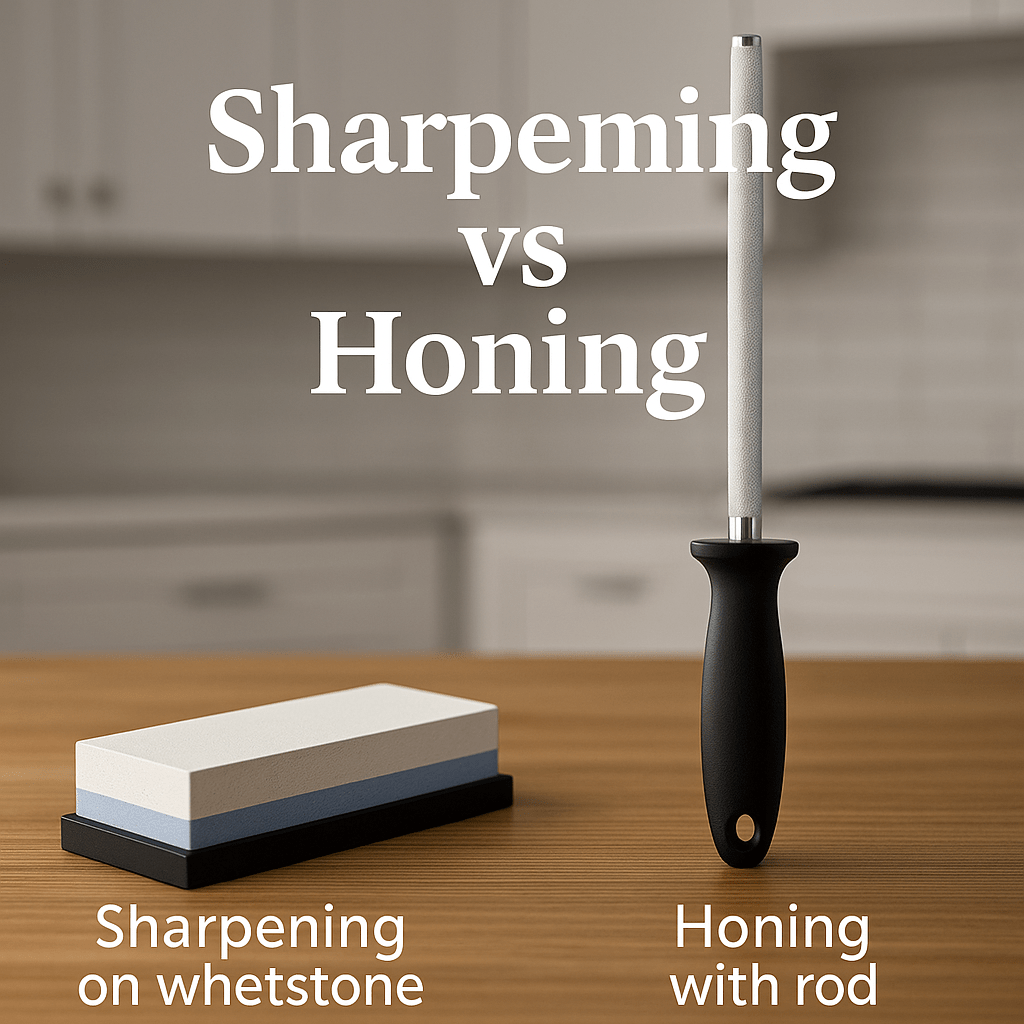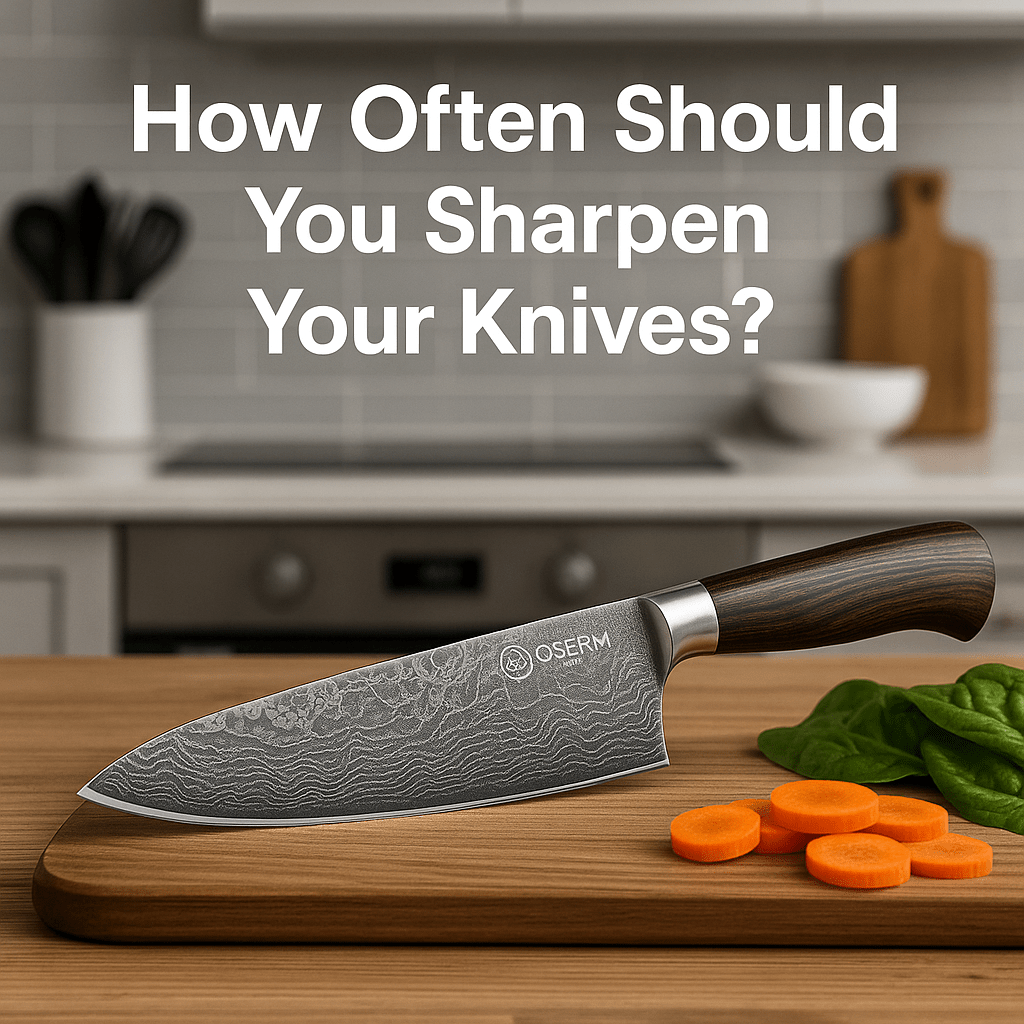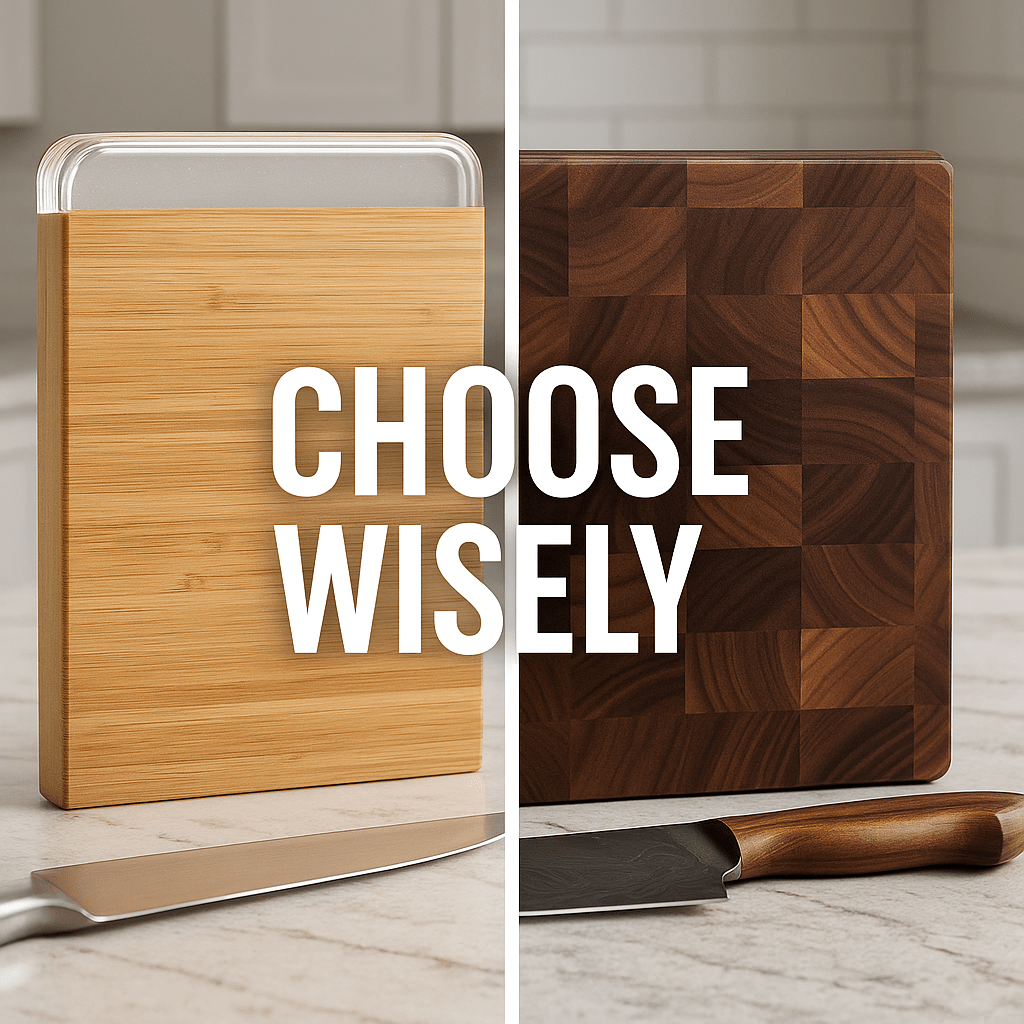
Sharpening vs Honing – Why Most People Confuse Them
Almost every home cook has done it — grabbing a honing rod and proudly saying, “I just sharpened my knife!” But here’s the truth: honing is not sharpening. While the two terms are often used interchangeably, they’re completely different techniques that serve unique purposes. Understanding this difference is the secret to keeping your knives in perfect condition for years — especially your OSERM VG-10 Damascus knives.
Why the Confusion Exists
The confusion comes from the fact that both honing and sharpening make a knife feel sharper — but they do so in very different ways. Honing realigns the blade edge, while sharpening rebuilds it. The results might feel similar at first, but their impact on your knife’s lifespan and performance couldn’t be more different.
What Is Honing?
Honing is like a quick tune-up for your knife. Every time you cut food, the ultra-thin edge of the blade bends microscopically to one side. Honing gently straightens that edge back into place — restoring sharpness without grinding away steel. It’s a daily or weekly maintenance step that keeps your knife performing smoothly.
- Goal: Realign the knife’s existing edge.
- Tools: Ceramic or steel honing rod.
- When to Do It: Before or after every major cooking session.
- Effect: Feels sharper, but no steel is removed.
What Is Sharpening?
Sharpening is a more intensive process. Over time, the knife’s edge becomes so worn that honing alone can’t restore it. Sharpening removes a small amount of metal from the blade to create a completely new edge. This is done using abrasive tools such as whetstones, waterstones, or even professional sharpening machines.
- Goal: Rebuild the edge by removing metal.
- Tools: Whetstone, waterstone, or precision sharpener.
- When to Do It: Every 2–3 months for home cooks (more often for professionals).
- Effect: Restores the knife’s razor-sharp cutting performance.
The Science Behind It
Your knife edge is not a flat line — it’s a microscopic wedge. When viewed under a microscope:
- After use, the edge bends slightly out of alignment (needs honing).
- After months of use, microchips and dull spots form (needs sharpening).
Honing preserves steel. Sharpening removes steel. The combination of both keeps your OSERM knife sharp longer while minimizing wear on the blade.
How to Hone Properly
1️⃣ Hold your honing rod vertically with the tip resting on a cutting board. 2️⃣ Hold the knife at a 15° angle for Japanese knives (like OSERM Damascus). 3️⃣ Lightly glide the blade from heel to tip along the rod, alternating sides. 4️⃣ Repeat 5–10 times per side using smooth, gentle motions.
The goal is not to grind — it’s to straighten. Too much pressure bends the edge further instead of fixing it.
How to Sharpen Properly
Sharpening requires patience and consistency. Here’s a simple 3-step guide using a 1000/6000-grit whetstone:
- Soak the whetstone for 10–15 minutes before use.
- Hold the knife at a 15° angle and gently slide it across the stone, heel to tip, maintaining even strokes.
- Use the 1000 grit side to rebuild the edge, then polish with the 6000 grit side for a mirror finish.
For Damascus blades, avoid electric sharpeners — they’re too aggressive and can destroy the layered steel pattern.
Key Differences at a Glance
| Feature | Honing | Sharpening |
|---|---|---|
| Purpose | Realign bent edge | Rebuild dull edge |
| Frequency | Weekly or before every use | Every 2–3 months |
| Material Removed | None | Small amount of steel |
| Tool | Honing Rod | Whetstone or Sharpener |
| Effect on Blade Life | Extends lifespan | Shortens slightly (if overdone) |
Why Both Are Necessary
Skipping honing means your knife dulls faster. Skipping sharpening means your knife will eventually stop cutting. The two work together — honing for quick maintenance, sharpening for full restoration. For OSERM Damascus knives, combining the two ensures years of consistent, professional-level sharpness.
OSERM’s Expert Routine
- Hone: Every few uses with a ceramic rod.
- Sharpen: Every 2–3 months with a 1000/6000-grit whetstone.
- Store: On a magnetic knife strip to avoid edge contact.
- Cut: Only on wooden or bamboo boards.
Common Mistakes to Avoid
- Pressing too hard when honing (causes edge rolling).
- Using the wrong angle — keep it at 15° for Japanese blades.
- Using electric sharpeners on Damascus steel.
- Thinking honing alone can replace sharpening.
Conclusion
Think of honing as your knife’s daily exercise, and sharpening as its full spa treatment. Honing maintains performance; sharpening restores it. Both are essential to preserve the integrity and beauty of your OSERM Damascus knives.
When done properly, you’ll enjoy effortless slicing, cleaner cuts, and knives that last a lifetime — all while keeping their iconic Damascus wave patterns pristine.
Weekly Deal 🔥
Perfect your sharpening routine with OSERM’s Knife Maintenance Set — featuring a ceramic honing rod and a premium 1000/6000-grit whetstone designed for Damascus VG-10 blades.
Shop OSERM Knife Care Essentials →
You Might Also Like
- How Often Should You Sharpen Your Knives? – The Ultimate Guide
- Manual vs Electric Knife Sharpeners – Which Works Better?
- Honing Rod vs Sharpening Stone – What’s the Difference?
Tags: sharpening vs honing, knife maintenance, OSERM Damascus knives, VG-10 steel, whetstone, ceramic rod, Japanese knife care






